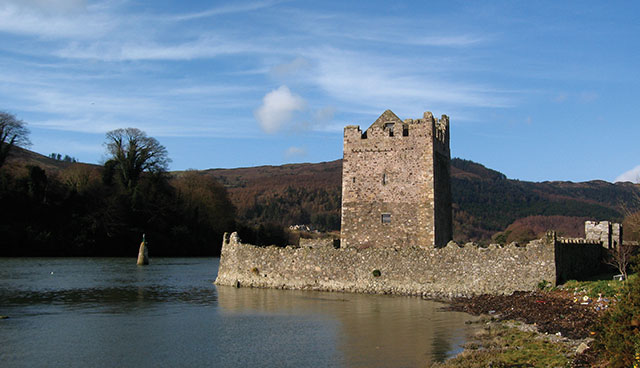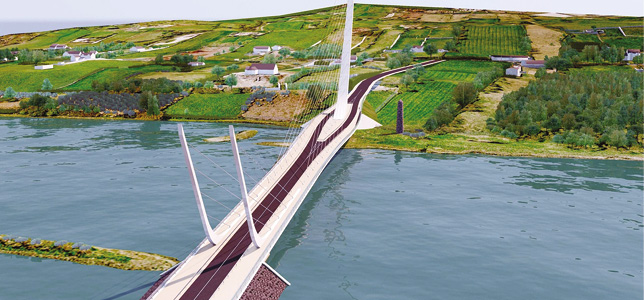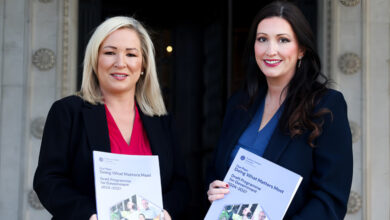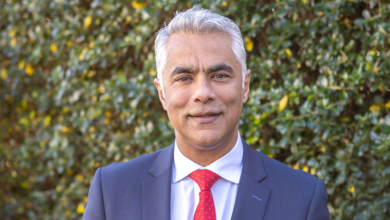Troubled bridge over Narrow Water

Proposals to build a tourism-boosting bridge spanning the Clanrye River between counties Down and Louth were first mooted in the 1970s. To date, while ‘shovel ready’, the bridge concept has failed to come to fruition. agendaNi explores the recent history of the project.
The site of the proposed bridge, at the narrowest point of the Clanrye River, one mile north-west of Warrenpoint on the northern side and two miles north-west from Omeath on the southern side, would connect the A2 dual-carriageway (via an additional arm at the existing A2 roundabout on the outskirts of Warrenpoint) and the R173 at Cornamucklagh.
Designed by Roughan O’Donnell Consulting Engineers (the company that designed the Mary McAleese Boyne Valley Bridge), the bridge is intended to be a single carriageway, 195 metre cable-stayed design, incorporating a pair of high towers at 33 metres and a single high tower at 86 metres, with a total length of 660 metres when taking account of the link road. Planning permission for the bridge required a movable section (with unlimited vertical clearance) which would allow the passage of watercraft and also incorporates segregated cycle and pedestrian paths. The proposed design speed for the link is 60 kph/40 mph, with no HGV restrictions and an average annual daily traffic (AADT) was predicted at a range of 1,036 and 3,767 by 2033. The 14-stage construction process was anticipated to extend over a 20-month period and infrastructure subsequently managed by Louth County Council and Newry, Mourne and Down District Council.
The significance of the bridge largely hinges on the tourism potential of a direct link between the Mountains of Mourne and the Cooley Peninsula and its symbolism. The vision was first conceived by Louth County Councillor Tommy Elmore from Omeath and Dr Donal O’Tierney from Warrenpoint in the 1970s. An extract from the Newry Reporter in January 1976 (‘Councillors say YES to bridge’) records: “Councillors from both sides of the border met in Newry on Tuesday to give their backing to a proposal to build a bridge linking Omeath and Warrenpoint… It was also recommended that further meetings be held to discuss the bridge link and also to talk about cooperation on the development of tourism, drainage control and control of pollution in Carlingford Lough.”
The meetings began informally between the Newry and Mourne and Louth County councils, but by 1978 Down District and Monaghan County were brought on board through the creation of a formal cross-border committee (the East Border Region Committee). However, an initial application for European Funding was unsuccessful. In 1979, while an engineering survey indicated that a bridge would feasible, the IRA killings of 18 British soldiers in an ambush on the northern shore and subsequent death of an English businessman on the southern shore as soldiers opened fire across the waterway reduced appetite for the project. By 1991, the Narrow Water Bridge Action Group was re-established and the project has been promoted by continuous lobbying since.
In 2000, Louth County Council awarded a contract to MC O’Sullivan consulting engineers to carry out a feasibility study of the proposed site the following year. Prior to this study, Dr O’Tierney noted: “Heretofore the Roads Division of the Department of the Environment in the North has been reluctant to commit itself to support the bride without concrete evidence of its advantages.”
By February 2007, Fianna Fáil Minister for Foreign Affairs Dermot Ahern provided a written response to former Louth TD Arthur Morgan indicating that the Government’s €120 billion National Development Plan for 2007-2013 contained a commitment to the project. “One of the key priorities is improved access along the Eastern Corridor, including links between County Louth and County Down. The development of Narrow Water Bridge would obviously be an important element of that proposal,” he wrote. Indeed, the SDLP’s late PJ Bradley asserted that he had received assurances that the Irish Government would contribute €14 million. However, former UUP Newry and Armagh MLA Danny Kennedy labelled the proposed bridge as “unnecessary” and “a misty-eyed project that has no economic benefit to the Newry area”.
“While our ambition remains to see this socially and economically desirable project through to completion, the reality is that it is now effectively on hold.”
Ultimately, 2007 proved to be the untimely end of the Celtic Tiger-era and in the subsequent economic maelstrom, the €800 million cross-border capital spending projects were scrapped, the Narrow Water Bridge among them. By July 2011, then Minister for Transport, Tourism and Sport Leo Varadkar concluded: “I have examined this report and recommendations and based on the economic appraisal, the current financial circumstances, competing demands from other local authorities for strategic schemes which have a better benefit/cost ratio, this Department is not in a position to proceed any further with the Narrow Water Bridge project, and beyond 2011 no further funding will be made available for it.”
Regardless, Louth County Council expressed a willingness to continue with the next stage of the planning process utilising its own resources and in the hope of securing INTERREG funding. In a written response to Louth TD Gerry Adams, Minister Varadkar noted: “I have no objection to this… They will need to secure a commitment from the Northern Ireland authorities to fund in the order of 75 per cent of the project from their resources (some of which could be recouped through INTERREG). To date this commitment has not been forthcoming.”
There was a significant delay in then Finance Minister Sammy Wilson’s decision regarding the proposed bridge. In late 2012, the SDLP’s Karen McKevitt brought forward a motion calling on the Executive to “make explicit their support for the project” and for the Finance Minister to “make clear his commitment to the successful delivery of the Narrow Water Bridge project and to take the lead, along with his counterparts in the Irish Government, in ensuring that any remaining finance required to complete the funding package is committed immediately”. The motion passed (47 to 38), though Wilson contended that there was “a political smell” and asserted: “Let us knock on the head at the very start the idea that this will open some golden era of tourism potential.”
Wilson’s reluctance to make a decision centred on the cost, the benefit, the believability and associated risks. “Until this project is completed, the risk of the whole cost of the bridge rests with the Executive in Northern Ireland. If this bridge were not completed on time, with the final bills in by June 2015 deadline, we would lose all of the money that had been put into this project,” he said.
“The Irish Government will also give consideration to other infrastructure commitments, including the concept of the Narrow Water Bridge.”
Latterly, he approved a Department of Finance contribution of £2,691,880 under the condition that Louth County Council would have “sole responsibility for any cost overruns associated within the eligible spend timeframe and in the event that the project would extend outside this period” and meet “all the maintenance and associated costs related to the upkeep of the bridge and its service area”.
In the event, despite securing planning permission from An Bord Pleanála and the then Environment Minister Alex Attwood, alongside €17.4 million from the INTERREG IVA programme, tenders received by Louth County Council from construction firms during 2013 “ran substantially over budget” and ranged from €26 to €40 million plus VAT. Efforts to close the funding gap failed, in spite of the efforts of one benefactor who was said to be working on a €4 million package for the project. Therefore, with a substantial funding shortfall, the Council acknowledged: “While our ambition remains to see this socially and economically desirable project through to completion, the reality is that it is now effectively on hold.”
At the seventeenth Special EU Programmes meeting of the North South Ministerial Council in May 2014, agreement was reached following the withdrawal of the Narrow Water project which saw INTERREG IVA funds reallocated to upgrade the Enterprise Service and refurbish the Drogheda Viaduct. At the same time, a joint communique from the meeting notes: “Ministers remain supportive of the concept of the Narrow Water Bridge.”
Regardless, ambitions for the completion of a bridge at Narrow Water are still very much alive. As recently as January 2017, former Infrastructure Minister Chris Hazzard and the Irish Minister for Tourism, Transport and Sport Shane Ross emphasised a continued commitment to the Narrow Water Bridge Project. Indeed, the Fresh Start Agreement established a joint Irish Government and Northern Ireland Executive commitment to the project.
Likewise, alluding to the Irish Government’s latest multi-annual 10-year capital plan during a visit to Queen’s University Belfast in August 2017, Taoiseach Leo Varadkar outlined a series of cross-border projects that would receive renewed consideration. “We remain committed to contributing £75 million to the construction of the A5. In this context, the Irish Government will also give consideration to other infrastructure commitments, including the Ulster Canal, the concept of the Narrow Water Bridge, and improving line speeds on the Dublin to Belfast rail line.”
Indeed, at the eleventh hour in October 2017, as planning permission was set to expire (following five years of ennui), Louth County Council hired contractors to commence development on the northern shore in accordance with approved plans. This ‘substantial start’ secured planning permission indefinitely. While aspirations are still evident, in the absence of an Executive an end point remains out of sight.







